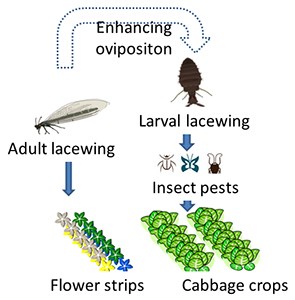Project resposible: Teun Dekker, Department of Plant Protection Biology, SLU, Alnarp.
Project member: Belén Cotes Ramal, Department of Plant Protection Biology, SLU, Alnarp.
In intensive agriculture, lack of non-crop habitats has a negative impact on conservation of beneficial arthropods. Local manipulation practices can improve biological control by increasing the abundance and fitness of natural enemy species.
The hypothesis for this study is that different flowering plants growing in the vicinity of cabbage fields have considerable potential to enhance lacewings as biological control agents of insect pests, because adult lacewings can use these flowers as pollen and nectar sources and locate suitable oviposition sites in adjacent crops, where their larvae prey on immature stages of the most important cabbage pests (Figure 1).
The overall goal of this project is to reduce pesticide use for cabbage pest control by helping growers decide which flowering plants to use to promote lacewings.
The three specific objectives of this project are:
- To screen for Chrysopidae populations in cabbage crops and examine the impact of flowering sources in their assemblages in a field experiment.
- To qualitatively identify pollen contents of the diverticulum of Chrysopidae adults consumed in flowers of the strips.
- To determine prey preferences of Chrysopidae larvae in the most important insect cabbage pests by PCR-based techniques for detecting prey remains in the gut of the larvae.
